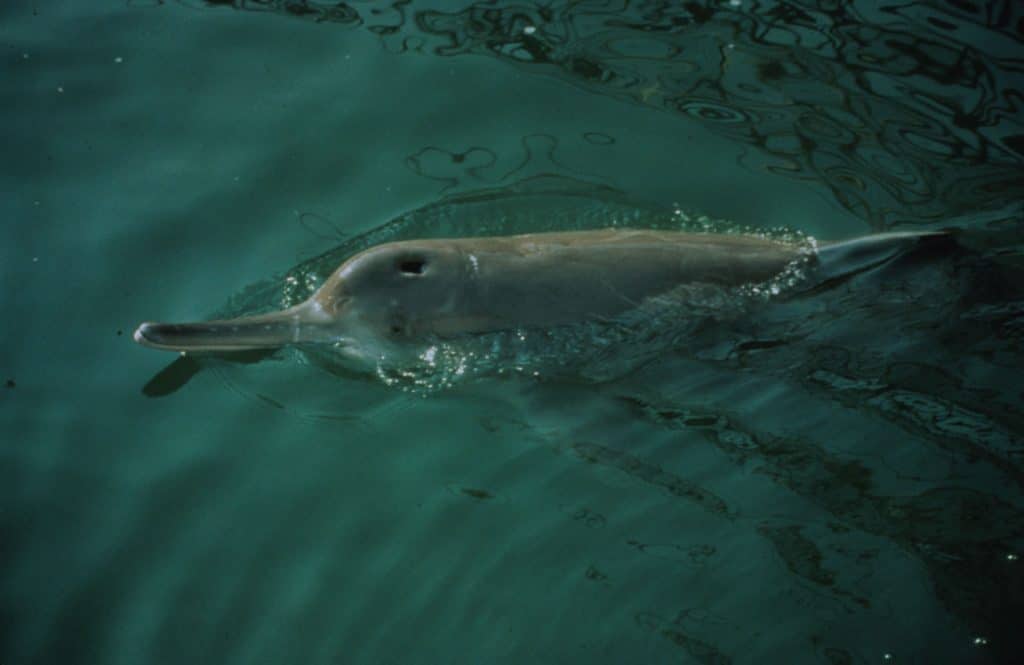This article is about the dolphin. For other uses, see Baiji (disambiguation).
| Baiji[1] | |
|---|---|
| Qiqi, the last confirmed baiji, who died in 2002 | |
| Size compared to an average human | |
| Conservation status | |
 Critically endangered, possibly extinct (IUCN 3.1)[2] | |
| CITES Appendix I (CITES)[3] | |
| Scientific classification | |
| Domain: | Eukaryota |
| Kingdom: | Animalia |
| Phylum: | Chordata |
| Class: | Mammalia |
| Order: | Artiodactyla |
| Suborder: | Whippomorpha |
| Infraorder: | Cetacea |
| Clade: | Delphinida |
| Superfamily: | Lipotoidea |
| Family: | Lipotidae |
| Genus: | Lipotes Miller, 1918[4] |
| Species: | L. vexillifer |
| Binomial name | |
| Lipotes vexillifer Miller, 1918[4] | |
| Natural range of the baiji | |
The baiji (Lipotes vexillifer) is a probably extinct species of freshwater dolphin native to the Yangtze river system in China. It is thought to be the first dolphin species driven to extinction due to the impact of humans. This dolphin is listed as “critically endangered: possibly extinct” by the IUCN, has not been seen in 20 years, and several surveys of the Yangtze have failed to find it. The species is also called the Chinese river dolphin, Yangtze river dolphin, Yangtze dolphin, and whitefin dolphin. The genus name Lipotes means “left behind” and the species epithet vexillifer means “flag bearer”. It is nicknamed the “Goddess of the Yangtze” and was regarded as the goddess of protection by local fishermen and boatmen.[5] It is not to be confused with the Chinese white dolphin (Sousa chinensis) or the finless porpoise (Neophocaena phocaenoides). This is the only species in the genus Lipotes.
What did baijis look like?

The baiji had a stocky body with broad, rounded flippers. The head was small with a prominent melon, a very long, narrow beak which was slightly upturned at the tip and a long mouth line. The baiji’s eyes were tiny and positioned higher up on the head than in other species of dolphin. The dorsal fin was small and triangular with a wide base and was located more than halfway back. Baijis were generally bluish grey colour on their back and greyish white on the lower part of the body.
What was life like for a baiji?

Baijis lived in small groups of two to six; the largest group recorded was 16 baijis. They were not demonstrative dolphins and usually surfaced without much disturbance. They were quiet and shy and difficult to approach since they would actively avoid boats. Baijis primarily relied on echolocation to find their way around and hunt freshwater fish in the river and connecting lakes. The baiji’s eyesight was poor and anyway not particularly useful because visibility in the water often wasn’t good.
Unfortunately the baiji’s ability to communicate, navigate, avoid danger and find food using echolocation became increasingly challenging as the river became a noisy place to live. Human exploitation and development of the Yangtze River rapidly escalated and the associated noise pollution increased rapidly as hundreds of boats using the river quickly became thousands of noisy ships using it as an aquatic highway. Life must have been very difficult for the surviving baijis and then the final nail in the baiji’s coffin came in the form of the Chinese approval of the Three-Gorges Dam construction. The building of this mega hydroelectric dam of mind-boggling proportions began in 1994 and construction took several years; it caused huge-scale environmental damage to the Yangtze River, destroyed wildlife habitats and wiped out native species.
A live caught female baiji was found to be 24 years old. This was therefore minimum life expectancy estimate for wild baijis.
The age of sexual maturity for male baijis was about 4 years old and for females was about 6 years old. Baiji pregnancies lasted for 10–11 months. Female baijis gave birth to a single baby every few years.
What did baijis eat?
Baijis ate a wide variety of freshwater fish, including both surface and bottom feeders.
Where did baijis live?
The baiji was a freshwater dolphin that lived only in the Yangtze River in China. The Yangtze is the third longest and largest river in the world and the biggest river in Asia. Baijis lived largely in the mainstream of the middle and lower reaches of the Yangtze River and two large connecting lakes – Dongting and Poyang.
Baijis were usually seen close to sandbars which are created where tributaries enter the main river and sediments are deposited. These sandbars create eddies in the water which are nutrient-rich and attract fish. Baijis (and fishermen alike) favour these habitats to catch fish.
